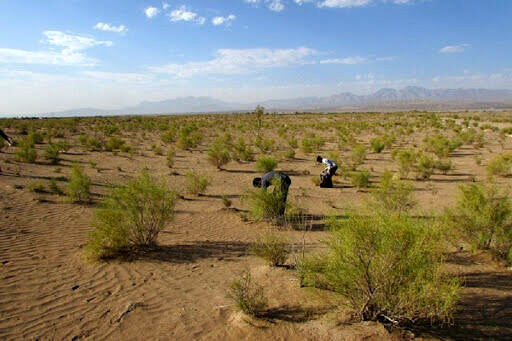300,000 ha undergoes desertification control annually

TEHRAN – Plans to combat desertification is being implemented on 300,000 hectares of land annually, the director of the desert office of the Natural Resources and Watershed Management Organization, has announced.
Desertification plans include planting seedlings, managing runoff, and constructing windbreaks around farms and sand dunes, IRIB quoted Vahid Jafarian as saying on Monday.
Some 100,000 hectares of desert areas will be rehabilitated this year by creating the right conditions through the role of the private sector and the effective participation of local communities, he highlighted.
Drought is one of the consequences of climate change and has devastating effects on various areas that can be managed and overcome.
Innovative projects such as checkerboard windbreaks and gravel mulch are implemented. Referring to the sand and dust storms as the main consequence of drought inside and outside the country, he said that mismanagement in one country accelerates soil erosion conditions in another, and storms form that can sweep across several countries, while dust control solutions require a comprehensive regional plan.
Utilizing the capacity of the Convention to Combat Desertification as the most important international legal body to address land management is a good tool to help in the field of dust management diplomacy and address a comprehensive program with related countries, he explained.
Implementation of innovative projects such as checkerboard windbreaks in sand dunes, and the use of gravel mulch has started for the first time in Semnan province, and we are trying to develop these projects in other parts of the country, he said.
70-year history of dealing with desertification
Iran has a 70-year history of dealing with desertification and dust control, with about 5 million hectares of planted forests in sand and dust storm hotspots, especially in areas with less than 50 mm of rainfall, Ali Mohammad Tahmasebi, head of the national working group for mitigating SDSs, has said.
Studies by international organizations show that the Islamic Republic has recorded the highest number of reforested desert areas after China, he added.
Parviz Garshasbi, deputy head of the Forests, Rangelands, and Watershed Management Organization (FRWMO), has said that according to the Sixth National Development Plan, desert greening measures were to be carried out in 1,140,000 hectares of the country's deserts, but so far, the operations have been conducted in only 350,000 hectares of deserts.
An estimated 2 billion tons of soil is lost due to erosion in Iran annually, it takes an average of 400 years to form a centimeter of soil on the planet, he said, adding, in Iran's climate, this time is between 700 and 1000 years.
Wind erosion brings an annual economic and environmental damage of 30 trillion rials (nearly $714 million at the official rate of 42,000 rials) to the country, according to the latest studies in 2019.
“Over 88 percent of the country can be affected by desertification. According to the 2018 survey, 37 million hectares of the country are exposed to land degradation and 23 percent of the total area is subject to severe degradation in terms of reduction of vegetation and soil fertility.
Also, 22 provinces of the country with an area of 29.5 million hectares in 187 regions are affected by wind erosion and there are 237 crisis centers with an area of 13.9 million hectares due to the influx of annual quicksand to the railway infrastructure, roads, agriculture, and other parts are damaged,” he explained.
FB/MG
